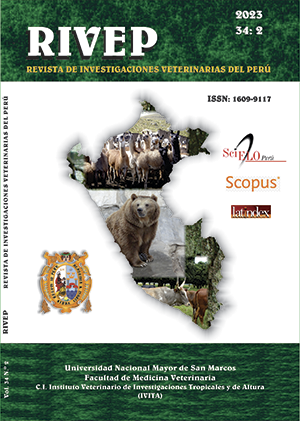Growth performance, proximal composition of muscle and haematological parameters of juveniles Colossoma macropomum fed with an all plant-based diet in comparison to a low-fishmeal diet
DOI:
https://doi.org/10.15381/rivep.v34i2.23524Keywords:
gamitana, fishmeal, vegetable ingredient, neotropical fish, omnivorous fishAbstract
The aim of this study was to determine the effect of a vegetable diet compared to a diet containing fishmeal at the commercial level (6%) on body growth, proximal composition of fillets and hematological parameters of juvenil gamitana (Colossoma macropomum). The experiment followed a completely randomized design with two treatments, an exclusively vegetable diet and a diet with low fishmeal content (6%), and three 200 m3 dug earthen ponds as experimental units per treatment. A total of 1200 fish (172.9 g; 19.4 cm) distributed in the six ponds (1 fish/m3) were used. Feeding was done twice a day (08:00 and 16:00) at a daily feeding rate of 2% for 60 days. The water quality parameters were monitored daily and showed constant values and within the comfort range of the species. The exclusively vegetable diet had a similar effect as the fishmeal diet on body growth [final weight 258.9 g, weight gain 86.1 g, supplied feed 128.4 g, feed conversion 1.24, relative growth rate 1.74%/day, factor of condition 1.91, 0% mortality], the proximal composition of fillets [moisture 77.90%, ash 1.39%, protein 18.98%, lipid 0.86%], as well as in the hematological parameters. It is concluded that an exclusively vegetable diet can be used for the rearing of juvenile gamitana, contributing to the sustainability of its production and reduction of feeding costs.
Downloads
Downloads
Published
Issue
Section
License
Copyright (c) 2023 Brenda Carolina Grande Fernández, Carlos Andre Amaringo Cortegano, César Augusto Villanueva Chávez, Ligia Uribe Gonçalves, Sandra Gracia Bezada Quintana, Fernando Demetrio Carcelén Cáceres, Sofía López Guerra

This work is licensed under a Creative Commons Attribution 4.0 International License.
AUTHORS RETAIN THEIR RIGHTS:
a. Authors retain their trade mark rights and patent, and also on any process or procedure described in the article.
b. Authors retain their right to share, copy, distribute, perform and publicly communicate their article (eg, to place their article in an institutional repository or publish it in a book), with an acknowledgment of its initial publication in the Revista de Investigaciones Veterinarias del Perú (RIVEP).
c. Authors retain theirs right to make a subsequent publication of their work, to use the article or any part thereof (eg a compilation of his papers, lecture notes, thesis, or a book), always indicating the source of publication (the originator of the work, journal, volume, number and date).










